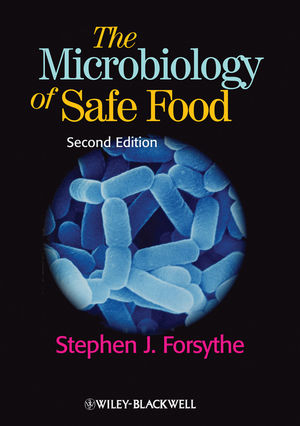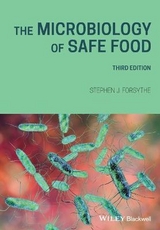
The Microbiology of Safe Food
Wiley-Blackwell (an imprint of John Wiley & Sons Ltd) (Verlag)
978-1-4051-4005-8 (ISBN)
- Titel erscheint in neuer Auflage
- Artikel merken
Food production is an increasingly complex and global enterprise,and public awareness of poisoning outbreaks is higher than ever.This makes it vital that companies in the food chain maintainscrupulous standards of hygiene and are able to assure customers ofthe safety of their products. This book reviews the production offood and the level of microorganisms that humans ingest, coveringboth food pathogens and food spoilage organisms. The comprehensivecontents include: * the dominant foodborne microorganisms; * the means of their detection; * microbiological criteria and sampling plans; * the setting of microbial limits for end-product testing; * predictive microbiology; * the role of HACCP; * the setting of Food Safety Objectives; * relevant international regulations and legislation.This updated and expanded second edition contains much importantnew information on emerging microbiological issues of concern infood safety, including: * microbiological risk assessment; * bacterial genomics and bioinformatics; * detergents and disinfectants, and the importance of hygienepractice personnel.The book is essential reading for all those studying foodscience, technology and food microbiology.
It is also a valuableresource for government and food company regulatory personnel,quality control officers, public health inspectors, environmentalhealth officers, food scientists, technologists andmicrobiologists.Web-based sources of information and other supporting materialsfor this book can be found at www.wiley.com/go/forsythe
Stephen J. Forsythe is Professor of Microbiology at Nottingham Trent University, UK. He has many years' experience of teaching food microbiology to university students, to professionals within the food industry and to personnel working in government regulatory bodies.
Preface to second edition xiv Preface to first edition xvi 1 Foodborne infections and intoxications 1 1.1 Origins of safe food production 1 1.2 Foodborne illness 2 1.3 Causes of foodborne illness 7 1.4 Public perception of safe food 8 1.5 Host-related issues 15 1.6 Hygiene hypothesis 17 1.7 The size of the foodborne illness problem 17 1.8 Chronic sequelae following foodborne illness 19 1.9 Changes in antibiotic resistance 21 1.10 The cost of foodborne diseases 22 1.11 Control of foodborne pathogens 26 1.12 Surveillance programmes 29 1.13 Outbreak investigations 36 1.14 Food terrorism and biocrimes 47 1.15 Food safety following natural disasters, and conflict50 2 Basic aspects 52 2.1 The microbial world 52 2.2 Bacterial cell structure 55 2.3 Bacterial toxins and other virulence determinants 58 2.4 Microbial growth cycle 65 2.5 Death kinetics 66 2.6 Factors affecting microbial growth 71 2.7 Microbial response to stress 75 2.8 Predictive modelling 80 2.9 Bioinformatic studies 87 3 The microbial flora of food and its preservation101 3.1 Spoilage micro-organisms 101 3.2 Shelf-life indicators 106 3.3 Methods of preservation and shelf-life extension 109 3.4 The hurdle concept 110 3.5 Preservatives 110 3.6 Physical methods of preservation 116 3.7 Fermented foods 125 3.8 Functional foods; prebiotics, probiotics and synbiotics136 3.9 Nanotechnology and food preservation 139 4 Foodborne pathogens 141 4.1 Introduction 141 4.2 Indicator organisms 151 4.3 Foodborne pathogens, bacteria 153 4.4 Foodborne pathogens, viruses 197 4.5 Seafood and shellfish poisoning 207 4.6 Foodborne pathogens: eucaryotes 210 4.7 Mycotoxins 214 4.8 Emerging and uncommon foodborne pathogens 218 5 Methods of detection and characterisation 224 5.1 Prologue 224 5.2 Conventional methods 229 5.3 Rapid methods 234 5.4 Rapid end-detection methods 238 5.5 Molecular typing methods 248 5.6 Specific detection procedures 250 5.7 Accreditation schemes 265 6 Microbiological criteria 266 6.1 Background to microbiological criteria and end-producttesting 266 6.2 International Commission on Microbiological Specificationsfor Foods (ICMSF) 266 6.3 Codex Alimentarius principles for the establishment andapplication of microbiological criteria 267 6.4 Sampling plans 269 6.5 Variables plans 271 6.6 Attributes sampling plan 274 6.7 Principles 275 6.8 Microbiological limits 281 6.9 Examples of sampling plans 282 6.10 Implemented microbiological criteria 286 6.11 UK guidelines for ready-to-eat foods 288 7 Hygienic production practices 289 7.1 Contribution of food handlers to foodborne illness 289 7.2 Personal hygiene and training 289 7.3 Cleaning 292 7.4 Detergents and disinfectants 294 7.5 Microbial biofilms 295 7.6 Assessment of cleaning and disinfection efficiency 299 8 Food safety management tools 301 8.1 The manufacture of hygienic food 301 8.2 Microbiological safety of food in world trade 307 8.3 Consumer pressure effect on food processing 308 8.4 The management of hazards in food which is in internationaltrade 309 8.5 HACCP 309 8.6 Prerequisite programme 310 8.7 Outline of HACCP 312 8.8 Microbiological criteria and HACCP 317 8.9 Microbiological hazards and their control 319 8.10 HACCP plans 321 8.10.1 Production of pasteurised milk 321 8.11 GMP and GHP 327 8.12 Quality systems 336 8.13 TQM 336 9 Microbiological risk assessment 338 9.1 Risk analysis and microbiological risk assessment 338 9.2 Origin of microbiological risk assessment 339 9.3 Microbiological risk assessment an overview 342 9.4 Microbiological risk assessment structure 344 9.5 Risk assessment 348 9.6 Risk management 368 9.7 Food safety objectives 373 9.8 Risk communication 374 9.9 Future developments in microbiological risk assessment376 10 Application of microbiological risk assessment 378 10.1 Salmonella risk assessments 378 10.2 Campylobacter risk assessments 388 10.3 L. monocytogenes risk assessment 394 10.4 E. coli O157 risk assessment 403 10.5 Bacillus cereus risk assessment 406 10.6 Vibrio parahaemolyticus risk assessment 407 10.7 Cronobacter spp. ( Enterobacter sakazakii ) and Salmonella in powdered infant formula 409 10.8 Viral risk assessments 410 11 International control of microbiological hazards in foods:regulations and authorities 412 11.1 World Health Organisation, global food security fromaccidental and deliberation contamination 412 11.2 The foodborne disease burden epidemiology reference group(FERG) 415 11.3 Regulations in international trade of food 416 11.4 Codex Alimentarius Commission 417 11.5 Sanitary and phytosanitary measures (SPS), technicalbarriers to trade (TBT) and WHO 417 11.6 European Union legislation 419 11.6.1 Food hygiene directive (93/43/EEC) 420 11.7 Food safety agencies 420 Glossary of terms 423 List of abbreviations 428 Food safety resources on the world wide web 429 References 435 Index 461 A colour plate section is found facing page 222 See the supporting companion website for this book : http://www.wiley.com/go/forsythe
| Verlagsort | Chicester |
|---|---|
| Sprache | englisch |
| Maße | 177 x 248 mm |
| Gewicht | 894 g |
| Themenwelt | Technik ► Lebensmitteltechnologie |
| Weitere Fachgebiete ► Land- / Forstwirtschaft / Fischerei | |
| ISBN-10 | 1-4051-4005-4 / 1405140054 |
| ISBN-13 | 978-1-4051-4005-8 / 9781405140058 |
| Zustand | Neuware |
| Informationen gemäß Produktsicherheitsverordnung (GPSR) | |
| Haben Sie eine Frage zum Produkt? |
aus dem Bereich



